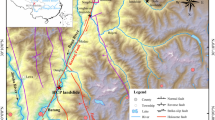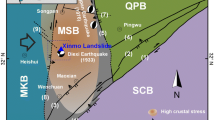Abstract
On 12 July 2018, the giant Jiangdingya ancient landslide reactivated and blocked the Bailongjiang River in Nanyu Town, Gansu Province, China. The ancient landslide was ca. 4.1~4.9 × 107 m3, and the 2018 reactivated landslide was ca. 4.8~5.5 × 106 m3, with the characteristics of a deep-seated retrogressive landslide. The terrain and geological structure of the landslide area are very complicated with alpine valleys and high gradient rivers, and the ancient landslide had maturely developed. The Pingding-Huama fault, which has been active since the late Quaternary, passed through the landslide region. Because of the active fault and tectonic uplift, the lithology is deeply fragmented. Based on the remote sensing interpretation and field investigation, development characteristics and reactivation mechanism of the Jiangdingya ancient landslide are described.










Similar content being viewed by others
References
Chen HK, Li JJ (1997) General approach on geomorphologic evolution in Bailongjiang basin since Quaternary. J Chongqing Jiaotong Inst 16(1):15–20 (in Chinese with English abstract)
Chen HT (1991) Brief introduction to NanYu big landslide, Zhouqu County, Gansu. NW Hydropower 4:63–63 (in Chinese)
Cruden DM, Varnes DJ (1996) Landslide types and processes, special report, transportation research board. Nat Acad Sci 247:36–75
Deng H, Wu LZ, Huang RQ, Guo XG, He Q (2017) Formation of the Siwanli ancient landslide in the Dadu River, China. Landslides 14(1):385–394. https://doi.org/10.1007/s10346-016-0756-9
Gil E, Długosz M (2006) Threshold values of rainfalls triggering selected deep-seated landslides in the polish Flysch Carpathians. Stud Geomorphol Carpatho-Balcanica 40:21–43
Govi M, Sorzana P, Tropeano D (1982) Landslide mapping as evidence of extreme regional events. Studia Geomorphol Carpatho-Balcanica 15:81–98
Guo CB, Montgomery DR, Zhang YS, Wang K, Yang ZH (2015) Quantitative assessment of landslide susceptibility along the Xianshuihe fault zone, Tibetan Plateau, China. Geomorphology 248:93–110. https://doi.org/10.1016/j.geomorph.2015.07.012
Huang RQ, Li WL (2011) Formation, distribution and risk control of landslides in China. J Rock Mech Geotech Eng 3(2):97–116. https://doi.org/10.3724/SP.J.1235.2011.00097
Huang X, Yang WM, Zhang CS, Shen JF, Liu T (2013) Deformation characteristics and formation mechanism of Xieliupo landslide in Zhouqu. J Geom 19(2):178–187 (in Chinese with English abstract)
Iverson RM, George DL, Allstadt K, Reid ME, Collins BD, Vallance JW, Schilling SP, Godt JW, Cannon CM, Magirl CS, Baum RL, Coe JA, Schulz WH, Bower JB (2015) Landslide mobility and hazards: implications of the 2014 Oso disaster. Earth Planet Sci Lett 412:197–208. https://doi.org/10.1016/j.epsl.2014.12.020
Jiang S, Wen BP, Zhao C, Li RD, Li ZH (2016) Kinematics of a giant slow-moving landslide in Northwest China: constraints from high resolution remote sensing imagery and GPS monitoring. J Asian Earth Sci 123:34–46. https://doi.org/10.1016/j.jseaes.2016.03.019
Li SZ, Dai S, Wang HW, Zhang X (2015) Fault features and their implications on distribution and formation of landslides in Bailongjiang region. J Lanzhou Univ (Natural Sciences) 51(2):145–152 (in Chinese with English abstract)
Li X, Liao Q, Wang S, Liu J, Lee S (2008) On evaluating the stability of the Baiyian ancient landslide in the three gorges reservoir area, Yangtze River: a geological history analysis. Environ Geol 55(8):1699–1711. https://doi.org/10.1007/s00254-007-1121-z
Liu XW, Yuan DY, Shao YX, Wu Z (2015) Characteristics of late Quaternary tectonic activity in the middle eastern segment of the southern branch of Diebu Bailongjiang Fault, Gansu. J Earth Sci Environ 37(06):111–119 (in Chinese with English abstract)
Martel SJ (2004) Mechanics of landslide initiation as a shear fracture phenomenon. Mar Geol 203(3):319–339. https://doi.org/10.1016/S0025-3227(03)00313-X
Meng YM, Chen G, Guo P, Xiong MQ, Janusz W (2013) Research of landslides and debris flows in Bailong River Basin: process and prospect. Mar Geol Quat Geol 33(4):1–15 (in Chinese with English abstract)
Mu P (2011) Analysis on causes and stability of landslide at Jiangdingya in Zhouqu County of Gansu Province. China Water Resourc (4):50–52 (in Chinese with English abstract)
Ren JZ (1993) The Nanyu landslip and small earthquake activity. NW Seisgeol J 15(2):94–96 (in Chinese with English abstract)
Ren D, Leslie LM, Lynch MJ, Duan QY, Dai YJ, Wei SG (2013) Why was the August 2010 Zhouqu landslide so powerful? Geogr Environ Sustain 6(1):67–79
Sassa K, He B (2013) Dynamics and prediction of earthquake and rainfall-induced rapid landslides and submarine megaslides. In: Sassa K, Rouhban B, Briceño S, McSaveney M, He B (eds) Landslides: global risk preparedness. Springer, Berlin, pp 191–211
Wang FW, Zhang YM, Huo ZT, Peng XM, Wang SM, Yamasaki S (2008) Mechanism for the rapid motion of the Qianjiangping landslide during reactivation by the first impoundment of the Three Gorges Dam reservoir, China. Landslides 5(4):379–386 https://doi-org-mc.conwr.net/10.1007/s10346-008-0130-7
Wang GX, Xu JL, Liu GD, Li CZ (2004) Landslide science and landslide control technology. China Railway Publishing House, Beijing
Wang JR, Qi L, Cai XX (1994) Analysis on landslide of Nanyu in Zhouqu County of Gansu Province. Bull Soil Water Conserv 14(1):57–60 (in Chinese with English abstract
Yang WM, Huang X, Zhang CS, Si HB (2014) Deformation behavior of landslides and their formation mechanism along Pingding-Huama active fault in Bailongjiang River Region. J Jilin Univ (Earth Sci Ed) 44(2):574–583 (in Chinese with English abstract
Yin YP, Zheng WM, Liu YP, Zhang JL, Li XC (2010) Integration of GPS with InSAR to monitoring of the Jiaju landslide in Sichuan, China. Landslides 7(3):359–365. https://doi.org/10.1007/s10346-010-0225-9
Yu JX, Zheng WJ, Yuan DY, Pang JZ, Liu XW, Liu BY (2012) Late Quaternary active characteristics and slip-rate and of Ping ding-Hua ma Fault, the eastern segment of Guanggaishan-Dieshan Fault zone (West Qinlin Mountain). Q Sci 32(5):957–967 (in Chinese with English abstract
Yuan RM, Tang CL, Deng QH (2015) Effect of the acceleration component normal to the sliding surface on earthquake-induced landslide triggering. Landslides 12(2):335–344. https://doi.org/10.1007/s10346-014-0486-9
Yuan RM, Deng QH, Cunningham D, Xu C, Xu XW, Chang CP (2013) Density distribution of landslides triggered by the 2008 Wenchuan earthquake and their relationships to peak ground acceleration. Bull Seismol Soc Am 103(4):2344–2355. https://doi.org/10.1785/0120110233
Zhang MS, Li TL (2011) Triggering factors and forming mechanism of loess landslides. J Eng Geol 19(4):530–540 (in Chinese with English abstract)
Zhang YS, Guo CB, Lan HX, Zhou NJ, Yao X (2015) Reactivation mechanism of ancient giant landslides in the tectonically active zone: a case study in Southwest China. Environ Earth Sci 74(2):1719–1729. https://doi.org/10.1007/s12665-015-4180-6
Acknowledgments
The authors are grateful to the anonymous reviewers and editors for providing useful comments and suggestions. The authors would like to thank Prof. Chengxuan Tan, Prof. Zhiheng Li, and Prof. Yuliang Cheng for their discussions on the landslide formation mechanism. Postgraduate students Yaqi Shen and Jian Liu participated in the field investigation and laboratory tests.
Funding
This study was supported by the National Natural Science Foundation of China (41731287, 41877279) and the China Geological Survey Project (DD20160271).
Author information
Authors and Affiliations
Corresponding author
Rights and permissions
About this article
Cite this article
Guo, C., Zhang, Y., Li, X. et al. Reactivation of giant Jiangdingya ancient landslide in Zhouqu County, Gansu Province, China. Landslides 17, 179–190 (2020). https://doi.org/10.1007/s10346-019-01266-9
Received:
Accepted:
Published:
Issue Date:
DOI: https://doi.org/10.1007/s10346-019-01266-9




